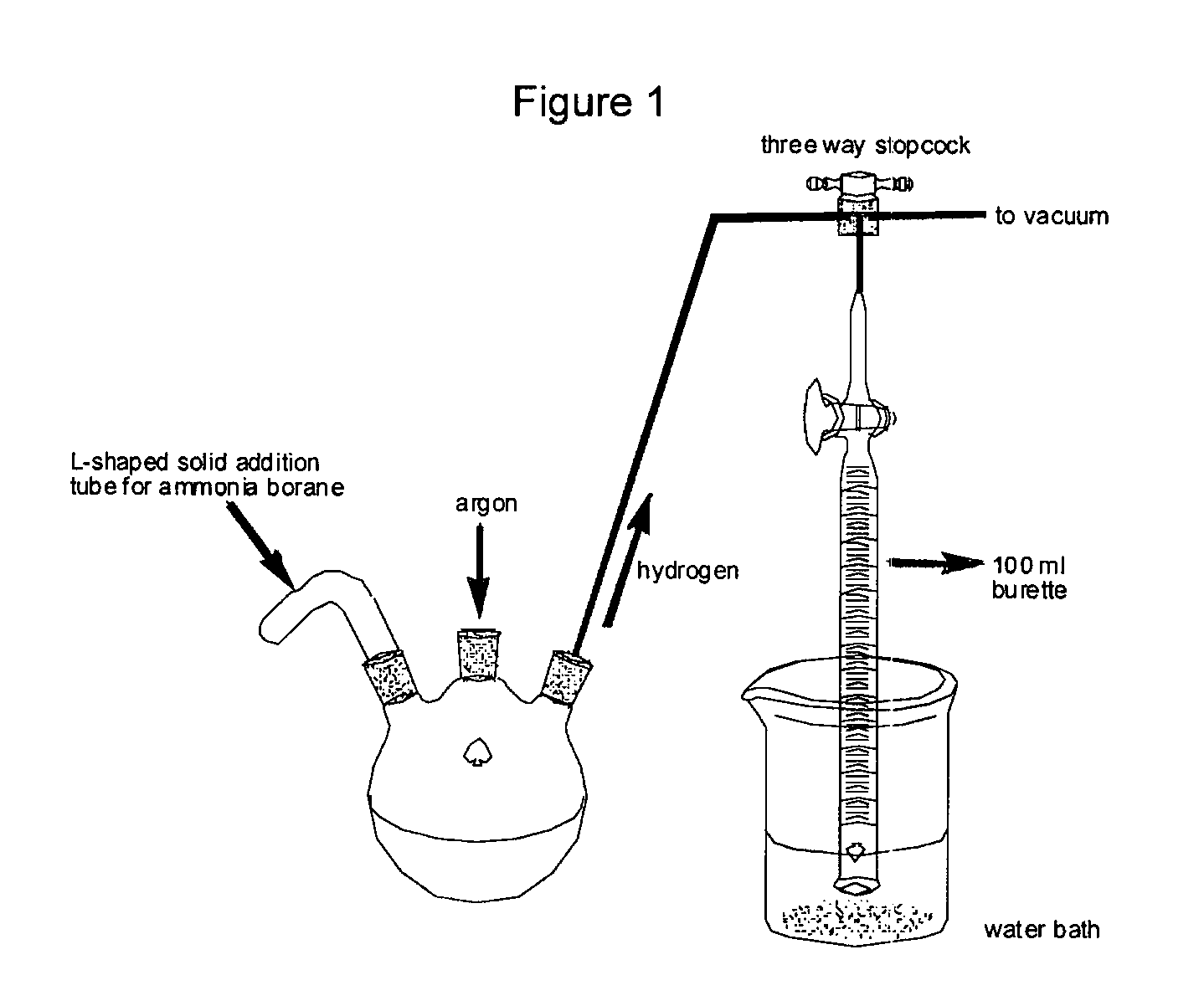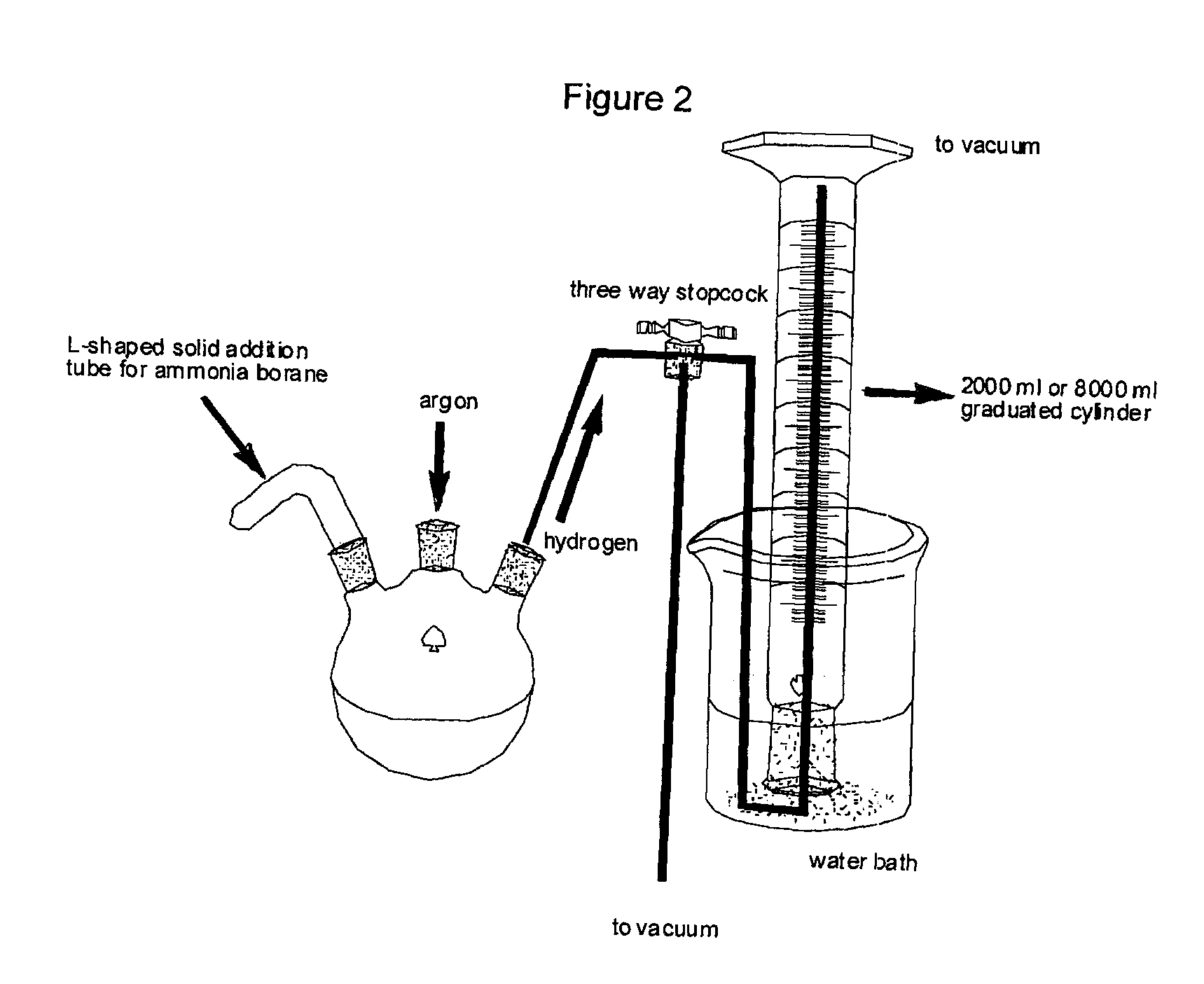Method for the production of hydrogen from ammonia borane
a technology of ammonia borane and hydrogen, which is applied in the direction of organic compounds/hydrides/coordination complexes, physical/chemical process catalysts, gas-gas reaction processes, etc., can solve the problems of limiting the potential widespread and large-scale use of hydrogen, and affecting the use of hydrogen as a fuel. achieve the effect of rapid hydrogen generation
- Summary
- Abstract
- Description
- Claims
- Application Information
AI Technical Summary
Benefits of technology
Problems solved by technology
Method used
Image
Examples
experimental examples
Materials and Methods
[0085]All ligands and their metal complexes were prepared under an argon atmosphere in an Innovative Technologies inert atmosphere glovebox or with standard Schlenk techniques, unless otherwise stated. All heterogeneous catalysts were prepared in air unless otherwise stated. Ammonia borane was obtained from Boroscience Ltd. Ruthenium trichloride trihydrate (RuCl3.3H2O) was obtained from Pressure Chemicals Company. Rhodium cyclooctadiene acetylacetonate [Rh(COD)(acac)], and [iridium bis(cyclooctene)chloride]dimer{[Ir(COE)2Cl]2} were obtained from Colonial Metals Inc. Palladium cyclooctadiene dichloride [Pd(COD)Cl2] was prepared using standard procedures. All other metal salts were obtained from Sigma-Aldrich Ltd. and were used as received. Dichloromethane (CH2Cl2), diethyl ether (Et2O), hexanes (C6H14), tetrahydrofuran and toluene (C7H8) were dried and degassed with an Innovative Technologies solvent column containing alumina (CH2Cl2), or alumina and copper oxide...
example 1
[0087]
(a) R=iso-propyl: 1,3-bis(di-iso-propylphosphinooxy)benzene
[0088]Resorcinol (3.5 g, 32 mmol) was dissolved in 100 ml of toluene and triethylamine (9.3 ml, 67 mmol) was then added to the reaction mixture. Chloro-di-iso-propylphosphine (10.6 ml, 67 mmol) in toluene (50 ml) was added dropwise to the reaction mixture at room temperature After 3 hours, the reaction mixture was then concentrated in vacuo. The product was then filtered in the drybox to remove the small amount of residual salt. Yield: 9.07 g (83%). 1H NMR (300 MHz, C6D6): δ 7.07 (m, 1H, 2-H), 6.8 (m, 1H, 5-H), 6.70 (m, 2H, 4- and 6-H), 1.89 (dsept., 4H, CH(CH3)2), 1.10 (m, 24H, CH(CH3)2). 31P{1H}NMR (300 MHz, C6D6): δ 150.
(b) R=tertiary butyl: 1,3-bis(di-tert-butylphosphinooxy)benzene
[0089]This material was prepared according to a literature method (Göttker-Schnetmann, I.; White, P.; Brookhart, M. J. Am. Chem. Soc. 2004, 126, 1804-1811). Yield: 4.50 g (45%) Spectroscopic data are similar to the literature value (Göttk...
example 2
[0093]
R=iso-propyl: 2,6-bis((di-iso-propylphosphino)methyl)pyridine
[0094]Chloro-di-iso-propylphosphine (10.0 g, 65.5 mmol) in 50 ml of tetrahydrofuran was added dropwise to a suspension of lithium (containing ca. 0.5% Na) granules (1.18 g, 170 mmol) in 50 ml of tetrahydrofuran and the mixture was stirred for 72 hours. The reaction mixture was then filtered, cooled to −80° C., and a solution of 2,6-bis(chloromethyl)pyridine (5.98 g, 34 mmol) in 20 ml of tetrahydrofuran was slowly added via a dropping funnel with vigorous stirring, resulting in the formation of a red solution. The mixture was allowed to warm to room temperature and was then refluxed for 1 hour; the color slowly changed from red to pale yellow with the formation of a precipitate. The reaction was followed by 31P NMR spectroscopy to ensure completion and then the solvent was removed in vacuo. Hexanes (50 ml) and water (25 ml) were then added and the water layer was then removed. The hexanes layer was then filtered seque...
PUM
| Property | Measurement | Unit |
|---|---|---|
| Flow rate | aaaaa | aaaaa |
| Solubility (mass) | aaaaa | aaaaa |
| Miscibility | aaaaa | aaaaa |
Abstract
Description
Claims
Application Information
 Login to View More
Login to View More - R&D
- Intellectual Property
- Life Sciences
- Materials
- Tech Scout
- Unparalleled Data Quality
- Higher Quality Content
- 60% Fewer Hallucinations
Browse by: Latest US Patents, China's latest patents, Technical Efficacy Thesaurus, Application Domain, Technology Topic, Popular Technical Reports.
© 2025 PatSnap. All rights reserved.Legal|Privacy policy|Modern Slavery Act Transparency Statement|Sitemap|About US| Contact US: help@patsnap.com



